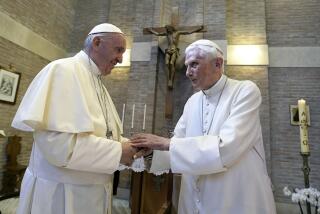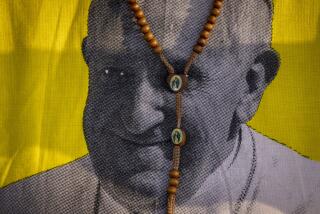PERSPECTIVE ON RELIGION : Catholics Go Their Own Way : Harassing the laity on marital sex arose in the last 70 years, going against the grain of a diverse church.
It is time for those who are not Catholic to suspend their efforts to explain what Catholicism is to us who are Catholics--as many in the media attempted to do during the latest Popery festival.
I had a (friendly) argument with Sam Donaldson on ABC. He had always understood, he said, that Catholicism is a list of doctrines and rules that you have to accept to be Catholic. If you donât accept them, then youâre not a Catholic. Kind of an extended loyalty test.
Wrong!
I understand his problem. What he thinks is what many of us were taught in catechism class, but being inside the church, we knew better than to take such rigidity seriously. I suppose outsiders have reason to be confused.
Catholicism is not an exclusivist sect with rigid boundaries. It is a rich, complex, diversified, pluralistic heritage. Anyone who has read Catholic history is well aware that its tradition has always been pluralistic and that it has defined its boundaries out as far as possible, to include everyone it can. In the words of one of the great Catholic theologians of the present century, James Joyce, Catholicism means HCE--Here Comes Everyone.
Canon law recognizes this. You stop being a Catholic not when you break a rule, not when you disagree with the Pope, but only when you formally and explicitly renounce your faith or join another religious denomination. Even then, the imagery and stories of Catholicism are so powerful that they continue to lurk in the imagination. Once a Catholic, always a Catholic.
The idea that âcafeteria Catholicismâ (as the media people are pleased to call it) is unique to our time and indeed to our country is historically absurd. The Pope and the bishops may tell Catholics what rules they are supposed to keep, but even church leaders know better than to threaten to toss you out if you donât keep the rules. We donât do excommunications any more and we never did them all that much. Moreover, the Inquisition is long since out of business, and the âsecular authorityâ is no longer in the hip pocket of the Catholic leadership (though until recently it did conspire in many places to cover up sexual abuse by priests). As for what goes on in the marriage bed, the laity have traditionally gone their own way, and the church has traditionally let them.
Thus in the last century, while the French were resolving their demographic revolution by coitus interruptus, the Vatican repeatedly told the French hierarchy not to trouble the consciences of the married laity. St. John Vianney, the patron saint of parish priests, warned the clergy to leave the laity alone on the subject of marriage relations. Pope Leo XIII wrote his encyclical on marriage at that time and did not once mention contraception. Harassing the laity on marital sex is, in great part, a development of the last 70 years.
St. Augustine, who has dominated official theological thinking on the subject, argued that sex was justified only for procreation and was even then sinful because of loss of control. But most lay people did not read St. Augustine (because for most of the time they could not read) and they did hear the marriage liturgy in which the union between man and woman was compared to that between God and the church, the marriage bed was blessed and prayers were said that the wife be âcompliant and vigorousâ in bed (prayers that we would now want to see extended to the husband).
Other saints--Gregory of Nazianzem, John Chrysostom and Alphonse Liguori, for example--emphasized the goodness and holiness of the human body and the virtue of marital union.
The second tradition appears to have won. According to surveys that the media seem to have missed last week, American Catholics have sex more often, are more playful in their sex and seem to enjoy it more than do Americans of other religions.
It is not my intent to argue about the birth-control controversy--though the laity and the parish clergy have elected to ignore the Vaticanâs teaching, which no one claims to be âinfallible.â I contend merely that the practical conclusions drawn in different times and different places about marital sex illustrate the pluralism of the Catholic heritage.
Finally, the Catholic tradition has always believed that Godâs spirit speaks to the Christian people through church leaders and to the leaders through the people. For the first millennium of Catholic history, important documents always included the notation, âwith the consent of the whole Christian people.â Pope John Paul II has echoed that doctrine when he wrote in his exhortation âFamiliaris Consortioâ that the married laity have a âunique and indispensableâ contribution to make to the churchâs understanding of human sexuality. The problem just now seems to be that no one is listening for this contribution.
As to who is a âgood Catholicâ and who isnât, that is a judgment that might be better left to God. Whoever else and whatever else God may be, She is not a moral theologian or a TV anchorperson.


